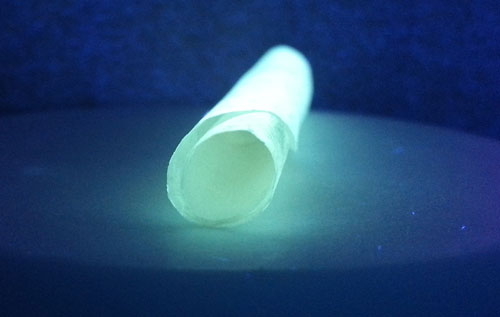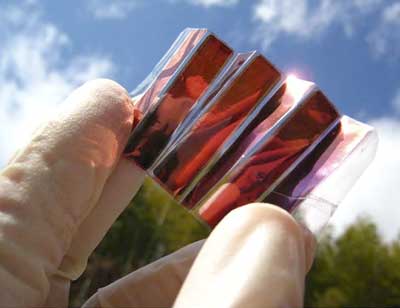| Jul 17, 2023 | |
Green flexible electronics based on natural materials |
|
| (Nanowerk Spotlight) The field of flexible electronics has witnessed a significant surge in recent years, driven by the increasing demand for portable and wearable devices, soft robotics, biomedical equipment, and human-machine interfaces. However, the conventional plastic-based electronics that have dominated the market are raising serious ecological concerns. Their limited lifetimes and non-biodegradability result in substantial plastic waste and pollution. This has led to an urgent call for sustainable, eco-friendly materials to develop "green" flexible electronics that are biocompatible and cause no harm to the environment. | |
| A recent review paper in Advanced Materials ("Green Flexible Electronics: Natural Materials, Fabrication, and Applications") presents an overview of green flexible electronics made from natural materials and their fabrication for applications. | |
 |
|
| An environmentally-friendly nanocellulose/quantum dot paper that glows could lead to sustainable, roll-up electronics. (© ACS) | |
Natural Materials: The Green Alternative |
|
| Recent research has focused extensively on utilizing natural materials such as silk, wood, paper, plant fibers, and biomass for fabricating green electronics. These materials are abundant, low-cost, renewable, and biodegradable, making them an ideal alternative to conventional plastics. | |
| Silk, obtained from silkworms and spiders, is known for its exceptional toughness and tensile strength. It has been used in the fabrication of organic electrochemical transistors and electronic skin (e-skin) for monitoring subtle physical signals, such as heart rate and pulse. For instance, researchers have developed an alternative green option to the current type of ionic conductors based on organic silk and inorganic synthetic nanoclay for the display and wearables industry via flexible and eco-friendly ionics. | |
| Wood, with its abundant cellulose fibers and hydroxyl groups, is beneficial for conducting ions and electrons. It has been used to fabricate sodium-ion batteries due to its mesoporous structure, which makes it an ideal electrolyte reservoir and mechanical buffer. Researchers have also developed a practical and versatile method for making wooden surfaces electrically conductive by graphitising them. | |
| Paper, made of cellulose pulp, is lightweight, flexible, and easily processed. It has been transformed into flexible and wearable sensors for daily human motion monitoring. Other natural materials like leaves, cotton, wool, hair, and other plant parts offer unique structures and properties for electronic applications. For example, researchers have made conductive nanopaper out of nanocellulose and silver nanowires. It still conducts electricity after being folded in half 500 times. Some nanopapers have reached 90% transparency, while others are in the 80% range similar to plastic. | |
 |
|
| Portable solar cells based on foldable, lightweight, transparent, conductive cellulose nanofiber paper. (Image: CC-BY Macmillan Publishers Ltd) | |
Fabrication Techniques for Green Flexible Electronics |
|
| With suitable physical or chemical processing, the structures of these natural materials can be modified and their properties tuned to meet the mechanical, electrical, optical, and thermal requirements for specialized flexible electronic components and devices. A range of fabrication techniques have been developed specifically for patterning electronics on natural material substrates. | |
| Printing methods like inkjet printing, screen printing, and 3D printing allow precision patterning of circuit components on flexible surfaces. Coating techniques such as dip coating, drop casting, and Meyer rod coating are used to deposit functional nanomaterials in thin uniform films. Direct writing with laser or conductive pens enables rapid prototyping. Chemical synthesis routes like hydrothermal growth, electrochemical deposition, and pyrolysis induce carbonization or polymerization in natural scaffolds. | |
| In addition to these, there are other chemical methods employed for fabricating green flexible electronics. For instance, pyrolysis has been used to create 2D and 3D structures using carbon and SiO2/carbon core-shell nanofibers on silk fabric and konjac glucomannan and flexible SiO2 nanofibers respectively. | |
Applications and Challenges |
|
| The excellent progress in green flexible electronics demonstrates the capabilities of natural materials to substitute conventional plastics. Electrical components such as wires, antennas, thermal management devices, transistors, sensors, and memristors have been fabricated on paper, silk, wood, and textiles. Energy harvesting nanogenerators and solar cells provide sustainable power sources. | |
| Supercapacitors and batteries based on composite paper, textiles, and wood store energy. Electroluminescent displays on silk, leather, and gel substrates create dynamic visual output. Actuators derived from paper, textiles, and plants respond to electrical, humidity, and light signals. | |
| However, there are still challenges to be addressed for scalable manufacturing and stable performance of natural material electronics. Most fabrication techniques are manual and not optimized for mass production. The interfaces between functional nanomaterials and rough, porous substrates are often unreliable. Natural hydrophilic surfaces are prone to environmental degradation without proper encapsulation. Further research is needed on interfacial engineering, customizable nanomanufacturing processes, and protective packaging for long-term functionality. | |
| In conclusion, green flexible electronics leveraging natural materials and nanotechnology shows immense potential for sustainable, eco-friendly electronic devices. With continued advances in material sciences and nanofabrication techniques, high-performance customizable green electronics could become viable alternatives to conventional electronics in the near future. They hold promise for a wide range of applications from wearable health sensors, degradable biomedical implants, to compostable consumer electronics - and create a much greener world. | |
 By
Michael
Berger
– Michael is author of three books by the Royal Society of Chemistry:
Nano-Society: Pushing the Boundaries of Technology,
Nanotechnology: The Future is Tiny, and
Nanoengineering: The Skills and Tools Making Technology Invisible
Copyright ©
Nanowerk LLC
By
Michael
Berger
– Michael is author of three books by the Royal Society of Chemistry:
Nano-Society: Pushing the Boundaries of Technology,
Nanotechnology: The Future is Tiny, and
Nanoengineering: The Skills and Tools Making Technology Invisible
Copyright ©
Nanowerk LLC
|
|
|
Become a Spotlight guest author! Join our large and growing group of guest contributors. Have you just published a scientific paper or have other exciting developments to share with the nanotechnology community? Here is how to publish on nanowerk.com. |
|
